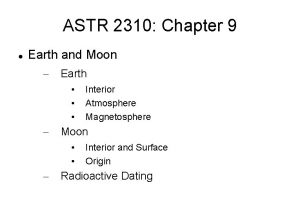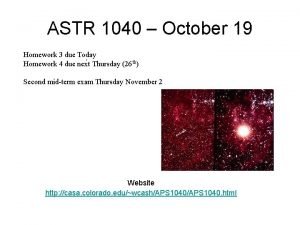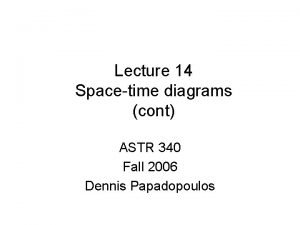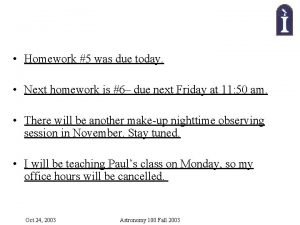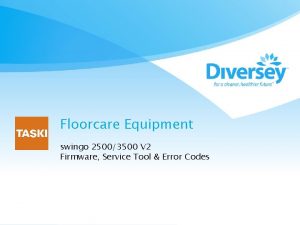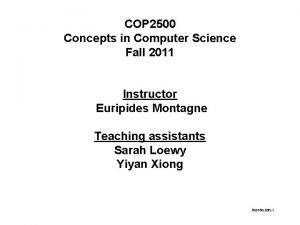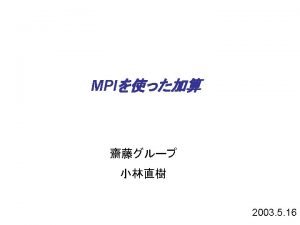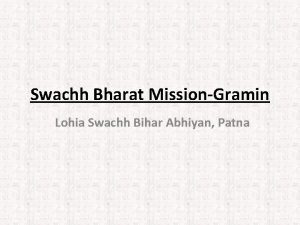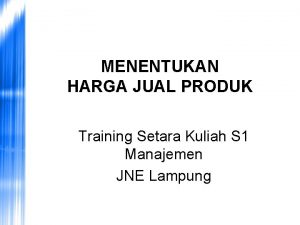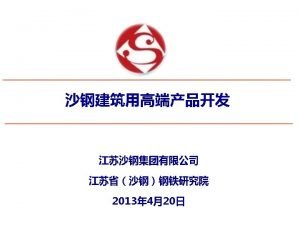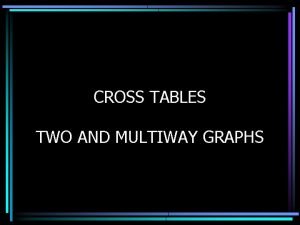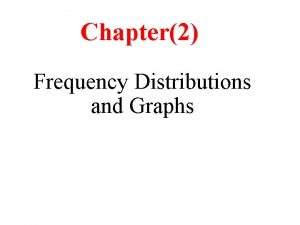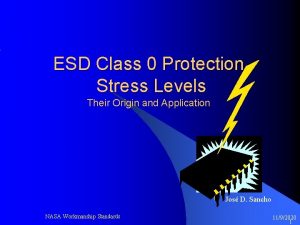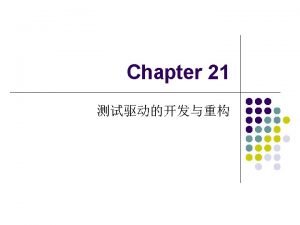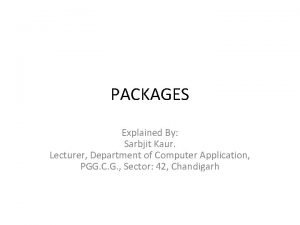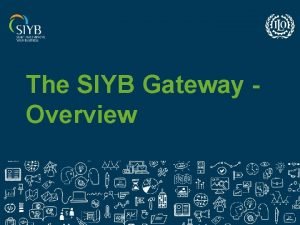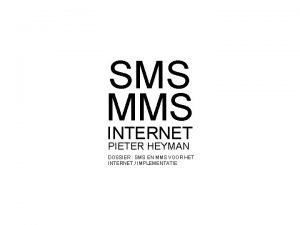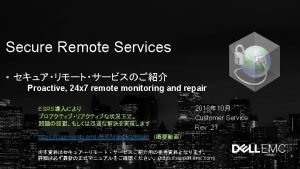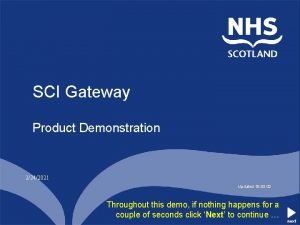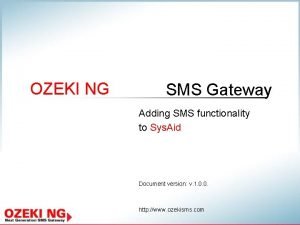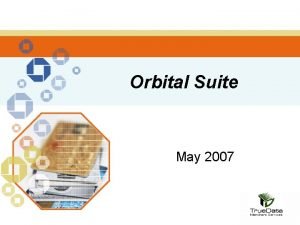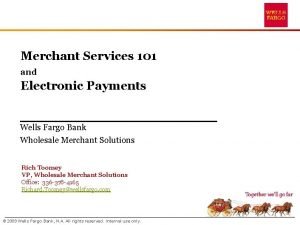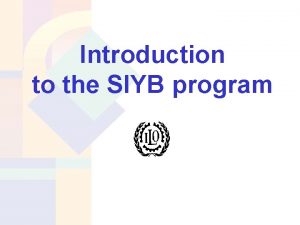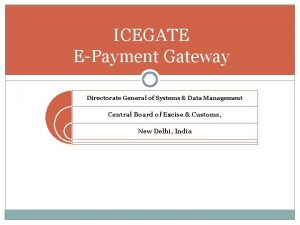Gateway To Space ASEN ASTR 2500 Class 08
























































































- Slides: 88

Gateway To Space ASEN / ASTR 2500 Class #08 Colorado Space Grant Consortium T-51

2

Today: - Announcements - Soldering 101 - Proposals DUE Friday, 9/16 at 12: 00 PM for Extra Credit OR - Proposals DUE Sunday, 9/18 at 1: 00 PM

Next Tuesday… Conceptual Design Review Slides DUE 7: 00 AM via email Prof. koehler@gmail. com Colorado Space Grant Consortium

Next Thursday… Guest Speaker – Jim Paradise Lockheed Martin Solar System Exploration Colorado Space Grant Consortium

Soldering 101 Colorado Space Grant Consortium

Soldering: 7

Caution: - Soldering is dangerous if not respected - Be mindful of where you are and where the soldering iron is - Eyes and liquid solder - Everyone is expected to solder - If you get burned… - Stay together, don’t work ahead

Caution: - Soldering is dangerous if not respected - Be mindful of where you are and where the soldering iron is - Eyes and liquid solder - Everyone is expected to solder - If you get burned… - Stay together, don’t work ahead

PCB – printed circuit boards Solder Pads Soldering Top View Side View Circuit Board Resistor 10

Prep Step 4: Tinning the iron (close-up) 11

Soldering Iron is only there for heat – to heat the board and part 12

Move soldering iron until tip is touching wire & solder pad Iron is only there for heat – to heat the board and part 13

Move solder to touch edge of tip. Solder Iron is only there for heat – to heat the board and part 14

Hold until solder melts on tip by wire Solder Iron is only there for heat – to heat the board and part 15

Move solder back to touch wire only Solder Iron is only there for heat – to heat the board and part 16

Move solder in to form a small pocket Solder Iron is only there for heat – to heat the board and part 17

Move soldering iron tip up. This will drag solder up with it. Solder Iron is only there for heat – to heat the board and part 18

Look for shinny fillets 19

Soldering Tips 1. Make sure tip is hot 2. Clean & tin tip 3. Keep tip clean by using wet sponge and cloth 4. Heat until the parts are hot enough to melt solder 5. Hold until solder flashes around pad 6. Do not put too much solder on 20

TIPS: - Use caution when clipping leads to avoid flinging metal across the room. - All soldering must achieve a good solder filet on the pad as shown for circuit reliability. workmanship. nasa. gov Example of a good solder filet - Also clip the leads in this fashion. - Bend resistors and diodes using your plastic tool as shown. 21

Tinned Copper Traces Top View 22

Soldered Top View Solder bridge shorting two traces - bad, bad But, can be fixed by reheating or using solder sucker 23

Today:

Board Safety: Caution: Many of the components used in this workshop are sensitive to electrostatic discharge (ESD). Please ensure that you are wearing your protective wrist strap at all times. There will be a warning slide when components are ESD and heat sensitive. Clipping leads can sometimes cause them to separate in a rapid manner that could cause injury. Please take caution when clipping leads. Wear your safety glasses at ALL TIMES! 25

Reading a Resistor: The resistors in this workshop have already been organized by value. In the event that your resistors get mixed, please refer to the chart at the left to classify your resistors, or use your multimeter. If you are unsure, don’t hesitate to raise your hand ask for assistance. 26

Pre-Bending: Pre-Bending 101: - Pre-bending is a technique that allows components to be easily inserted into a PCB. - Pre-bending also allows components to lay more flush with the board. - Bending components to the correct bend radius takes practice, but mastering the technique will reap rewarding benefits! 27

Pre-Bending: Pre-Bending 101: - Start with the bending and prodding tool in the position shown in the top picture. - Choose a location along the length of the tool that will yield the appropriate bend radius. 90° - Use your thumb to bend the lead such that the component and lead are orthogonal. 28

29

Hands-on: Soldering 14

Hands-on: Soldering - Get into your teams - Each person on the team will solder their own circuit - You and your team will have 50 minutes - Let me know when you are done 15

Prep Step 1: Tool Layout - Prepare tools for the construction process. - Put on your safety glasses. 32

Prep Step 2: Grounding - Put on a static strap to remain grounded. Also make sure the strap is tight across your wrist. - This will protect any parts from electro-static discharge (ESD) and its harmful effects. 33

Prep Step 3: Soldering Station - Turn on the soldering iron - Set the temperature control on the soldering iron to a temperature less than 700 °F and greater than 450 °F. - As a general rule use a temperature in the range between 550 and 650 degrees Fahrenheit. 34

Prep Step 4: Tinning the iron - Tin the tip of the soldering iron by melting an inch or so of solder on the tip. - The iron will now look shiny on the tip. - Then wipe any excess solder on the wet sponge. - Now place the iron back into the holder. Tinning your soldering iron in this manner will aid in future soldering. 35

Prep Step 4: Tinning the iron (close-up) Tip of the iron is not the hottest part 36

Voltmeter is very useful - 37

Voltmeter 101: - This is the set up typically used 38

Voltmeter Use this 101: setting to check resistor values 39

Use Voltmeter this 101: setting to check DC voltage 40

Use Voltmeter this 101: setting to check continuity 41

Hands-on: Soldering Step 1: Distribute solder kits among team You will have to share the soldering stations Help each other learn the techniques 16

Hands-on: Soldering Step 2: Layout kit (Socket not shown) 17

Hands-on: Soldering Step 3: Look at board, find reference point Install Side 18

Hands-on: Soldering Step 3: Look at board, find reference point Solder Side 19

Hands-on: Soldering Step 4: Flip board over and solder 8 pin socket Step 5: Install 555 timer. Small circle placed over pin hole “ 1” 20

Hands-on: Soldering Step 6: Flip board over and bend chip leads out DO NOT SOLDER AT THIS TIME 21

Hands-on: Soldering Step 7: Install 120 kΩ resistor (Brown, Red, Yellow) 22

Hands-on: Soldering Step 8: Install 33 kΩ resistor (Orange, Orange) 23

Hands-on: Soldering Step 9: Verify resistors 120 kΩ Brown, Red, Yellow 33 kΩ Orange, Orange 24

Hands-on: Soldering Step 10: Flip board over 120 kΩ Brown, Red, Yellow Step 11: Solder Resistors 33 kΩ Orange, Orange 25

Hands-on: Soldering Step 12: Inspect solder joints and trim leads 26

Hands-on: Soldering Step 13: Flip board over and install capacitor Gray strip indicates “negative” lead “-” Lead 27

Hands-on: Soldering Step 14: Verify capacitor is installed correctly “-” Lead 28

Hands-on: Soldering Step 15: Flip over board and solder capacitor “-” Lead 29

Hands-on: Soldering Step 16: Verify solder joint and clip leads 30

Hands-on: Soldering Step 17: Install RED LED over 120 kΩ Resistor Negative side is facing edge of board Negative Lead 31

Hands-on: Soldering Step 18: Install GREEN or YELLOW LED over 33 kΩ Resistor. Negative side is facing edge of chip Negative Lead 32

Hands-on: Soldering Step 19: Flip board over and solder LED leads 33

Hands-on: Soldering Step 20: Solder chip to board. Go slow Step 21: Verify solder joints and check for solder bridges 34

Hands-on: Soldering Step 22: Install 9 V battery clip to board 35

Hands-on: Soldering Step 23: Flip board over and solder battery leads 36

Hands-on: Soldering Step 24: Attach test battery and watch what you made NOTE: If it doesn’t work, detach battery immediately and have it inspected 40

Hands-on: Soldering When completed, please wait for further instruction 38

Heaters ASEN / ASTR 2500 Colorado Space Grant Consortium

Environments at 30 km: - You need to do something to keep your systems warm - Colorado history has shown payloads (batteries) begin to fail below -5°C - Hand warmers don’t work well without air (O 2) - You will use an active heater 66

Environments at 30 km: • Balloon. Sats can do real science at 100, 000 feet • Discoveries can be made • Atmospheric studies can be done • Engineering challenges are extreme • Enough unknowns to catch the mind of students 67

Hands-on: Heater Circuit - Dry ice test results have been excellent 68

Hands-on: Heater Circuit Kit includes: 3 1 3 3 1 1 1 9 Volt batteries (for flight only) Perf Board Ceramic Resistors (4 Ω @ 5 W) 9 V connectors White wire Blue wire Red wire Black wire Switch Female connector with red and black wire 69

Hands-on: Heater Circuit Set out kit 70

Hands-on: Heater Circuit Layout Resistors on Perf Board 71

Hands-on: Heater Circuit Layout Resistors on Perf Board Front Back 72

Hands-on: Heater Circuit Fold over the leads from two of the blocks and solder them together 73

Hands-on: Heater Circuit Snip the leads that you just soldered together 74

Hands-on: Heater Circuit Fold over the opposite two leads and solder so that all of the blocks are connected in parallel then clip the ends of the leads 75

Hands-on: Heater Circuit Solder resistors in series using leads of resistors 4Ω 4Ω 4Ω 76

Hands-on: Heater Circuit Twist all the Red wires from the 9 V connector together and solder them to the single BLUE wire in your kit 77

Hands-on: Heater Circuit Twist all the Black wires from the 9 V connector together and solder them to the single black wire from the female connector 78

Hands-on: Heater Circuit Check continuity for all “-” and “+” terminals to each other 79

Hands-on: Heater Circuit Check continuity for all “+” terminals of the battery with the end of the single BLUE wire Check continuity for all “-” terminals of the battery with the end of the single BLACK wire 80

Hands-on: Heater Circuit Check continuity for all “-” terminals of the battery with the BLACK wire on the connector 81

Hands-on: Heater Circuit Put electrical tape on solder joints 82

Hands-on: Heater Circuit Solder the single BLUE wire from 9 V connector to one end of the resistor string and the RED wire from the female connector to the other end of the resistor string 4Ω 4Ω 4Ω 83

Hands-on: Heater Circuit Connect the Switch (Black to Black, Red to Red) 84

Hands-on: Heater Circuit Final Product 85

Hands-on: Heater Circuit Attach 3 flight batteries and turn switch on. Your heater will get extremely hot with in 1 to 2 minutes. If it takes longer, please let me know. 86

Hands-on: Heater Circuit Turn switch off, disconnect the switch from the heater, leave batteries connected 87

Questions? Colorado Space Grant Consortium 88
 Robert asen
Robert asen Astr greek or latin
Astr greek or latin Astr
Astr 5-a-day language review answer key book 6
5-a-day language review answer key book 6 Astr
Astr Astr
Astr Homework due today
Homework due today Astr
Astr Astr twins
Astr twins That was due today
That was due today Astr ioi
Astr ioi Herbalife 2500 vp
Herbalife 2500 vp Taski swingo 2500 error codes
Taski swingo 2500 error codes Cuanto gana un president team de herbalife
Cuanto gana un president team de herbalife Computer science
Computer science Cop 2500
Cop 2500 Cop 2500
Cop 2500 Mpi 5001
Mpi 5001 The tension in the guy wire is 2500 n
The tension in the guy wire is 2500 n 350000/2500
350000/2500 A sealed 2500 cm3 flask
A sealed 2500 cm3 flask Vists 2500
Vists 2500 Cti 2500
Cti 2500 20000000/2500
20000000/2500 3000+2500+2000
3000+2500+2000 3650/2470
3650/2470 4000000/3500
4000000/3500 500 vp herbalife
500 vp herbalife Jarak kota p dan kota q dapat ditempuh selama 4 jam
Jarak kota p dan kota q dapat ditempuh selama 4 jam 40000/2500
40000/2500 2500/4/40
2500/4/40 2500/200000
2500/200000 Joint space vs cartesian space
Joint space vs cartesian space Space junk the space age began
Space junk the space age began Camera space to world space
Camera space to world space Cartesian space vs joint space
Cartesian space vs joint space World space computer
World space computer In today's class
In today's class Putting a package together
Putting a package together Abstract class vs concrete class
Abstract class vs concrete class How to calculate mode for grouped data
How to calculate mode for grouped data Class i vs class ii mhc
Class i vs class ii mhc Abstract concrete class relationship
Abstract concrete class relationship Width of class interval
Width of class interval Stimuli vs stimulus
Stimuli vs stimulus Discriminative stimulus psychology definition
Discriminative stimulus psychology definition 7 rights of medication administration in order
7 rights of medication administration in order Class maths student student1 class student string name
Class maths student student1 class student string name Categorical frequency distribution example
Categorical frequency distribution example In greenfoot, you can cast an actor class to a world class?
In greenfoot, you can cast an actor class to a world class? Static and dynamic class loading in java
Static and dynamic class loading in java Class 0 esd
Class 0 esd Static class diagram
Static class diagram Class 2 class 3
Class 2 class 3 Public class test subject extends test class
Public class test subject extends test class Package mypackage class first class body
Package mypackage class first class body Class third class
Class third class Uml private public protected
Uml private public protected Component class has composite class as collaborator
Component class has composite class as collaborator Oracle xml gateway outbound example
Oracle xml gateway outbound example Usps business gateway
Usps business gateway Toll fraud prevention
Toll fraud prevention Togo - a gateway to africa
Togo - a gateway to africa Siyb gateway
Siyb gateway Emvo master data guide
Emvo master data guide Nifa data gateway
Nifa data gateway Cipres portal
Cipres portal Honeytoken accounts ata
Honeytoken accounts ata Mms bericht
Mms bericht Gateway lonate pozzolo
Gateway lonate pozzolo Emc secure remote support
Emc secure remote support Sci gateway
Sci gateway Ibm candidate zone
Ibm candidate zone Project gateway review
Project gateway review Ozeki ng sms
Ozeki ng sms Application proxy filtering
Application proxy filtering Orbital payment gateway fees
Orbital payment gateway fees Father of modern art in the philippines
Father of modern art in the philippines Azure application gateway vs traffic manager
Azure application gateway vs traffic manager Wells fargo payment gateway
Wells fargo payment gateway Managed access gateway
Managed access gateway Ilo siyb gateway
Ilo siyb gateway Gateways to art: understanding the visual arts
Gateways to art: understanding the visual arts Icegate epayment gateway
Icegate epayment gateway Integrated eligibility system (ies)
Integrated eligibility system (ies) Gateway travel management
Gateway travel management Directional topo cloning
Directional topo cloning Gateway services limited
Gateway services limited Gateway ventajas y desventajas
Gateway ventajas y desventajas




